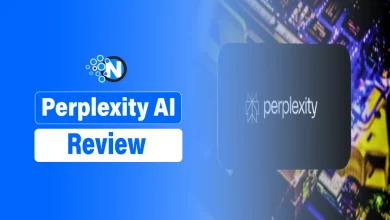How LLMs Are Democratizing Advanced IT Monitoring and Diagnostics
Keeping IT systems running smoothly is no small feat. Errors arise, performance drops, and identifying issues often feels like finding a needle in a haystack. For many businesses, the process of monitoring and diagnosing these problems consumes too much time and energy.
Large Language Models (LLMs) are helping a lot in this case. These AI tools can quickly analyze data, detect errors before they escalate, and even communicate findings in straightforward language.
This means both tech experts and everyday users can solve problems more efficiently than ever before.
In this post, I will discuss how large language models (LLMs) simplify advanced IT monitoring. You’ll discover how they automate tasks, reduce costs, and make diagnostics more accessible for everyone.
Ready to understand how it works? Keep reading!
How LLMs Enhance IT Monitoring?
LLMs improve IT monitoring by analyzing vast amounts of data almost instantly.
They simplify intricate technical tasks, ensuring systems operate more efficiently and intelligently.

Automating Error Detection
Cloud-based solutions make this automation available to businesses of any size. Instead of sifting through endless data manually, IT professionals can now focus on resolving the flagged problems directly. This is where partnerships with trusted providers like Managed IT from AT-NET help businesses stay proactive with automated monitoring tools.
Predictive maintenance becomes easier with automated monitoring that tracks performance patterns over time.
Cloud-based solutions make this automation available to businesses of any size. Instead of sifting through endless data manually, IT professionals can now focus on resolving the flagged problems directly. Automated error detection minimizes downtime risks and keeps critical systems running efficiently.
Real-time System Diagnostics
Real-time system diagnostics allow businesses to identify issues as they occur. With LLMs, networks are monitored continuously without interruptions. These models review logs and data streams instantly to detect errors before users become aware of any problems.
For example, if server latency increases during peak hours, an alert can immediately identify the bottleneck. Fast insights minimize downtime and enhance overall performance. Rather than relying on traditional troubleshooting methods, teams can resolve problems immediately. This enables managed IT services and professional IT support teams, such as those from a Pittsburgh-based IT outsourcing company, to oversee multiple systems effectively while avoiding costly interruptions.
Cloud-based AI tools further enhance this process by seamlessly extending monitoring across complex infrastructures.
Pattern Recognition and Anomaly Detection
LLMs process vast amounts of data to recognize patterns that might escape human attention. They highlight irregularities that stray from typical behavior, identifying problems before they grow.
For example, in network management, they can rapidly spot unusual traffic increases or unauthorized access attempts.
These systems also adjust as circumstances change. Machine learning improves its capacity to identify slight shifts over time. This results in more efficient diagnostics and improved predictive maintenance within IT settings.
Democratizing IT Diagnostics with LLMs
LLMs remove obstacles to accessing IT diagnostics. They make complex systems simpler to understand for everyone, not just tech experts.
Simplifying Complex Diagnostic Processes
Decoding error logs or tracking mysterious system glitches can feel like solving a jigsaw puzzle blindfolded. Large Language Models (LLMs) bring simplicity to this chaos by offering instant clarity.
They analyze piles of data to identify root causes quickly. For instance, if an application crashes, these models scan logs, flag problematic areas, and highlight fixes in seconds. This saves hours otherwise spent wading through technical jargon or complex code.
Mistakes often hide behind patterns humans fail to see. LLMs are highly effective at spotting trends across systems, be it recurring outages or subtle performance dips tied to specific updates.
Enabling Non-technical Users to Access Insights
Large Language Models make advanced IT monitoring accessible for everyone. These systems interpret technical data into straightforward language. Non-technical users can ask questions or describe issues in simple terms.
The AI processes these queries and provides clear, practical insights. This eliminates the need to interpret complex graphs or logs.
Integration with dashboards enhances this process. Visual tools combined with LLMs offer summaries, trends, and alerts instantly. For example, a manager could view real-time system performance without requiring engineering expertise.
Businesses save time while ensuring operations remain reliable and easy to understand for all staff levels.
Reducing Reliance on Specialized IT Teams
LLMs simplify IT monitoring by automating intricate processes. They analyze logs, identify patterns, and locate issues without needing advanced coding expertise. Individuals with basic technical knowledge can now resolve problems effectively.
These systems allow businesses to gain real-time insights using natural language queries. This minimizes the need for ongoing intervention from specialized IT staff, allowing resources to focus on other priorities.
Key Technologies Driving LLM-Powered IT Monitoring
Specific tools and methods make it possible for LLMs to change how IT teams manage systems—read on to learn about the main contributors behind this shift.
Retrieval-Augmented Generation (RAG)
Retrieval-Augmented Generation (RAG) combines retrieval systems with AI to provide precise answers. It gathers relevant data in real time from vast sources like cloud storage or databases.
The model then uses this information to generate accurate, context-aware responses.
IT teams benefit from RAG by accessing quick diagnostics and practical recommendations. Non-technical users can query complex IT issues using simple language without sifting through logs or reports.
This reduces delays and improves decision-making for businesses managing advanced IT monitoring tasks.
Advanced Natural Language Processing
LLMs apply advanced natural language processing (NLP) to make complex IT systems more understandable. They break down technical jargon and translate it into straightforward, practical insights for teams.
For instance, a cloud-based monitoring tool can identify server performance issues and explain the causes in clear terms. This reduces time spent interpreting logs or searching through documentation.
These models also excel at querying data in natural, conversational ways. Instead of learning specific commands, users can ask questions like “Why is the network slow today?” The system examines patterns, reviews logs, and provides direct answers or suggested fixes.
This functionality bridges the gaps between non-technical staff and detailed monitoring processes without requiring specialized training.
Integration with Existing IT Tools and Systems
Advanced natural language processing increases efficiency, but combining it with existing IT systems enhances this even more. Large language models now connect smoothly with tools like monitoring dashboards, ticketing systems, and cloud platforms.
These connections help businesses automate workflows. They also provide real-time insights by extracting data directly from active networks and applications. This reduces manual effort while improving accuracy in diagnostics.
Benefits of LLMs in IT Monitoring and Diagnostics
LLMs make identifying system issues faster and easier. They help teams address problems early, preventing them from escalating into larger challenges.
Faster Issue Resolution
Intelligent systems can now identify problems before they grow. Large Language Models (LLMs) simplify error diagnostics, enabling teams to respond quickly. For instance, instead of days spent analyzing logs, LLMs summarize issues in seconds. This quick response reduces downtime and keeps operations efficient.
Automated querying saves time for IT teams by identifying causes faster than manual checks. Business owners and managed service providers no longer need to sort through endless data; insights reach them directly.
Faster resolutions mean happier clients and fewer interruptions overall.
Improved System Performance
Quick error detection saves time, but improved system performance makes long-term gains. Language models process massive data logs to predict and fix potential issues before they interrupt workflows. This reduces downtime and keeps vital systems operating smoothly.
AI-powered tools also optimize resource allocation. They analyze usage patterns, helping IT teams balance workloads effectively. Overloaded servers or slow network speeds no longer hinder productivity. With these technologies, businesses maintain consistent operations without frequent troubleshooting.
Cost and Resource Efficiency
Improved performance naturally leads to better use of resources. LLMs automate repetitive monitoring tasks, reducing the need for large IT teams to manually oversee systems. They immediately identify issues, saving hours that experts would otherwise spend troubleshooting.
Cloud-based AI tools powered by LLMs lower costs by expanding IT diagnostics without extra hardware or personnel. Businesses can allocate funds toward growth instead of endless tech upgrades. Predictive maintenance through real-time monitoring also prevents expensive downtime and repair costs.
Challenges and Considerations
LLMs are highly capable, but they aren’t flawless. Balancing their possibilities with real-world constraints requires careful consideration.
Ensuring Data Privacy and Security
Securing sensitive data is a top priority in IT monitoring. Businesses manage increasing volumes of information such as financial records, customer details, and employee files. Reliable encryption methods safeguard this data during storage and transmission.
Multi-factor authentication provides an additional measure to prevent unauthorized access.
AI systems should minimize exposure by storing only necessary information for diagnostics. Data masking techniques further lower risks by removing identifiable details from datasets.
Routine audits help detect vulnerabilities before they result in breaches or compliance problems.
Managing Biases in AI Outputs
Biases can quietly creep into AI systems, often stemming from flaws in training data. Training on unbalanced datasets may lead to skewed outputs that misrepresent certain groups or scenarios. For businesses relying on advanced IT monitoring tools, such oversights could result in inaccurate diagnostics or unfair prioritization of issues.
Implementing diverse datasets during AI development reduces these risks. Regularly auditing model performance helps identify patterns of bias early. Tools like Retrieval-Augmented Generation (RAG) refine answers by pulling relevant information against queries, minimizing errors caused by outdated or biased sources. Keeping human oversight active ensures a balanced blend of automation and fairness across diagnostic processes.
Balancing Automation with Human Oversight
Automated IT monitoring tools handle intricate tasks such as identifying errors and conducting predictive maintenance. They accelerate processes but may struggle with understanding context or making detailed decisions. Human supervision is essential for ensuring accuracy and addressing mistakes that automation might overlook.
Large language models simplify data analysis; however, human verification is crucial, particularly in critical situations like network management or cloud-based diagnostics. Combining automation for efficiency with human oversight for accountability helps maintain smooth operations without sacrificing reliability.
Conclusion
Large language models are changing IT monitoring and diagnostics. They simplify complex tasks, making them accessible to more people. Businesses save time, reduce expenses, and resolve issues more quickly. Non-technical users now gain insights without requiring extensive expertise. This change creates more opportunities for everyone in tech management.
People Also Ask
What Is LLM In The IT Industry?
LLM is a type of trained AI that generates human-like text. In the IT industry, it is used to help professionals perform their work in a better way.
What Does LLM Stand For?
LLM stands for Large Learning Model.
What Can You Do With LLMs?
There are a bunch of different things that you can do with LLMs. They’re primarily designed to understand and generate human-like text. People are now using it for things like data analysis, task automation, and content generation.
How Do LLMs Work?
The working mechanism of LLMs is pretty straightforward. These models are trained on a massive amount of data to learn language patterns. They use this data to predict and generate content according to the provided commands.




